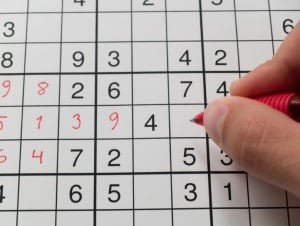
A staple of in-flight magazines, the pen-and-paper puzzler has become one of the most popular logic games in the world. Requiring no specialized know-how to play, it's a simply designed but tremendously challenging game. Yes, it involves digits, but it requires absolutely no math (and properly done, it requires absolutely no guesswork, either.)
It's a game of pure, cold, applied logic. Follow these tips, and your Sudoku career -- not to mention your brain -- will live long and prosper.
The rules
You're not going to get far if you don't understand the rules. Luckily, there are only three of them, and they're pretty straightforward.
-- Imagine the puzzle divided into nine horizontal rows. Each row has nine squares in it, and each number from one to nine should appear once -- and once only -- in that row.
-- Now picture the puzzle split into nine vertical columns. Again, each column has nine squares, and each one should contain all the numbers from one to nine.
-- Finally, you'll notice the puzzle is cut into nine three-by-three squares. Each of these larger squares contains nine small squares -- and each has to contain the numbers one to nine.
Easy, right? All those blank spaces might look daunting, but with just a few simple techniques you'll be equipped to handle just about anything those sneaky Sudoku masters throw at you. Read on.
The basics
Sherlock Holmes was fond of saying, "Once you have eliminated the impossible, whatever remains, however improbable, must be the truth." He wasn't talking about Sudoku (though we suspect he would have enjoyed the game), but Holmes's principle works for Sudoku as well as it works for finding crooks.
There are only nine possible answers (or "candidates") for each blank square, and the answers already on the grid will eliminate some of them. Once you've eliminated eight, you can be sure the one that remains is correct.
So for the first step, grab your pencil -- you are using a pencil, right? -- and mark each cell with its possible answers. Just look across the cell's column and row, and the other cells in its three-by-three square, and jot down the numbers that don't appear anywhere else, nice and small in a corner.
Once you've done that, look for any squares that are left with just one candidate. Fill those in with the answer; you're done there. Then, look for any squares that are the only occurrence of a particular candidate in their row, column, or three-by-three. If you have a square with candidates 2, 3, and 6, but 6 doesn't appear as a candidate anywhere else in its row, you know that square has to be a 6. Whenever you pin down a number, go through its row, column, and three-by-three, and cross out any other occurrences of that number from the possible candidates. Repeat those steps until you get stuck.
Pick out the twins
Next, look for cells in the same column, row, or three-by-three that have the same two candidates, and no others. Find a match, and you can strike out those two candidates from all other cells in that row, column, and three-by-three. Often that'll be enough to nail down another few cells and start the cycle all over again.
Track down the triplets
Still stuck? The twins technique also works for triplets, but you need three cells that share the same pool of three (and only three) candidates. So if you have a cell with candidates 1 and 8, another with candidates 4 and 8, and another with candidates 1 and 4 that share a row, column, or three-by-three, you can strike out all three of those numbers in all other cells in that row, column, or three-by-three.
"Slice and dice"
Finally, here's a classic technique for filling out a three-by-three region. Suppose you have such a square, and suppose you have already pinned down the locations of the 1, 2, 4, and 7. Pick one of the numbers that's missing -- say, 6 -- and look for 6s in the three-by-three boxes to the left and/or right of the one you're trying to complete. If you find a six, strike out its entire line. Do the same for columns. If you find you've struck out all the numbers in the three-by-three except one, you've found your 6. If not, try another number.
Never, ever guess
Remember: Sudoku games don't require guesswork. If you find yourself tempted to fill in an answer "just to see where it gets you," resist it. You've missed something elsewhere on the grid.
Lines of reasoning that are based on uncertain answers or trial-and-error lead to rabbit-warrens of confusing possibilities, dead ends, and frustration. Yes, it's possible to play that way -- guessing an answer and seeing if that line of thinking leads to an unsolvable grid -- but it's rarely wise, and never necessary.
Source: Click Here
Комментариев нет:
Отправить комментарий